外研版(2019)必修第三册Unit 5 What an adventure! Understanding ideas 课件(共33张PPT)
文档属性
| 名称 | 外研版(2019)必修第三册Unit 5 What an adventure! Understanding ideas 课件(共33张PPT) | 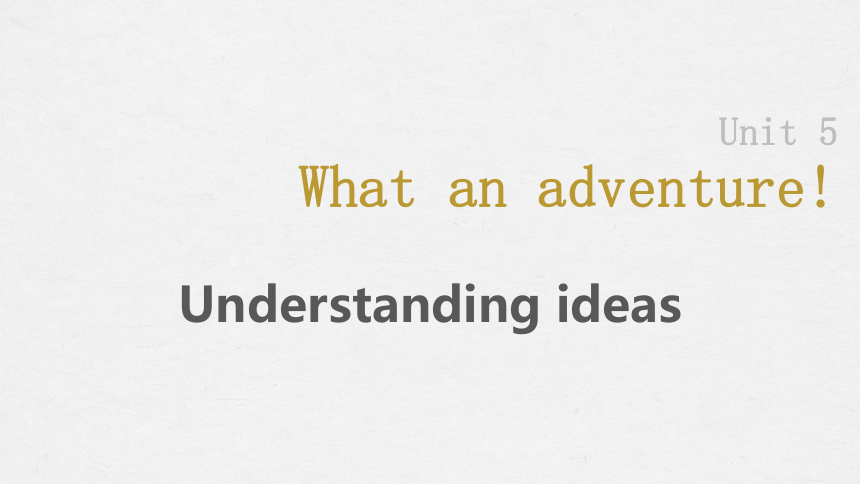 | |
| 格式 | pptx | ||
| 文件大小 | 10.5MB | ||
| 资源类型 | 教案 | ||
| 版本资源 | 外研版(2019) | ||
| 科目 | 英语 | ||
| 更新时间 | 2024-04-04 20:45:37 | ||
图片预览


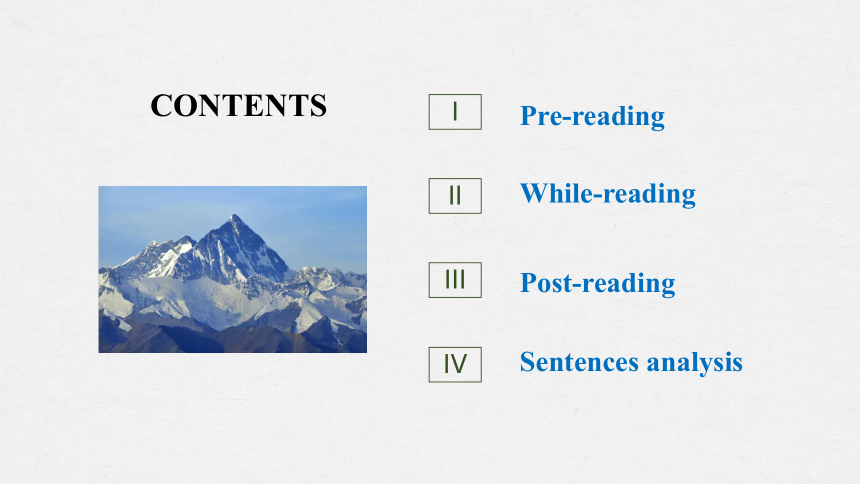
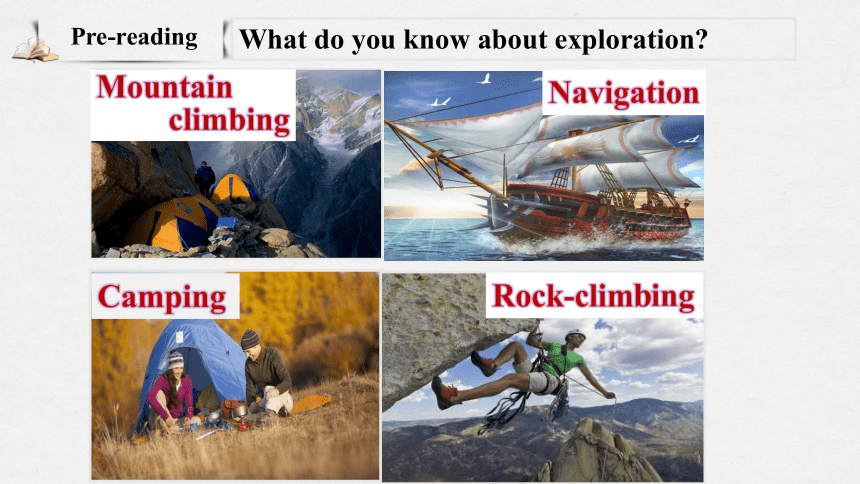

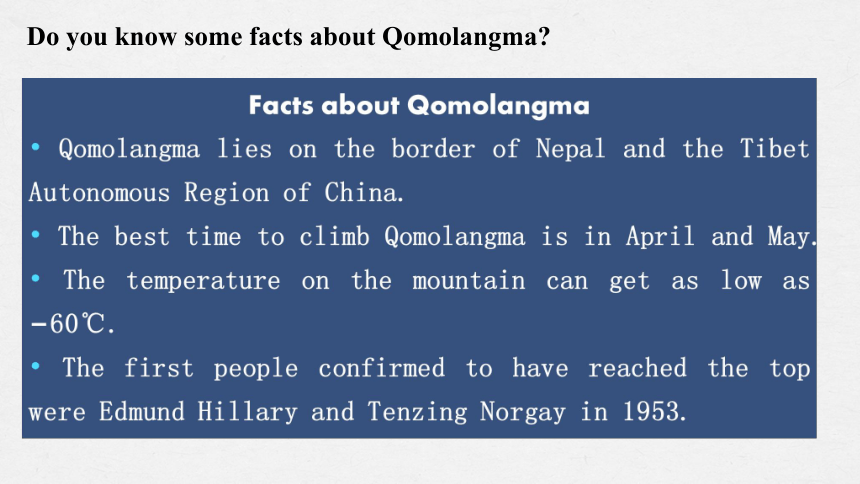

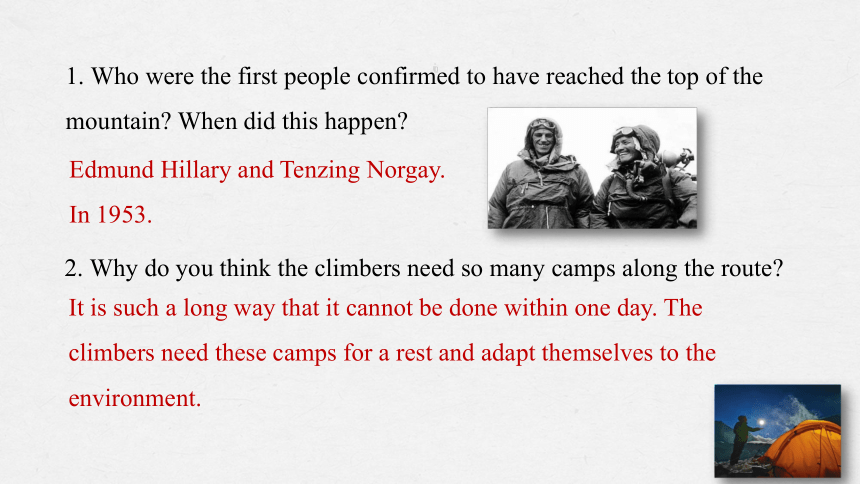
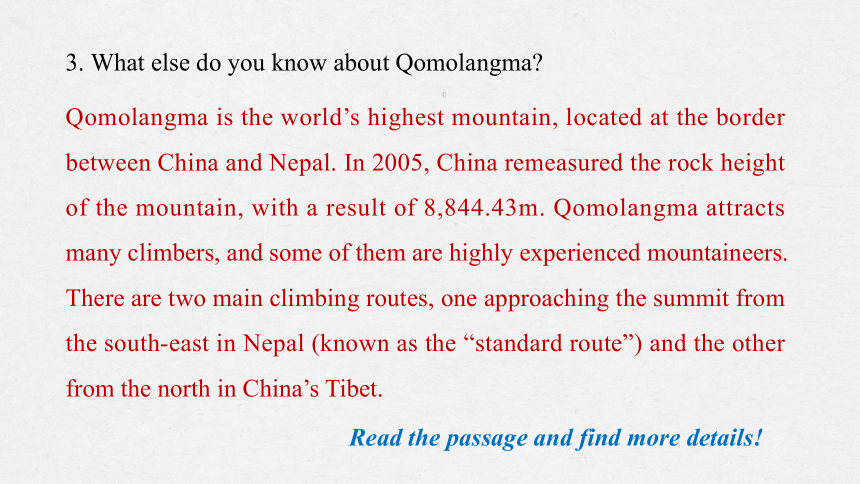
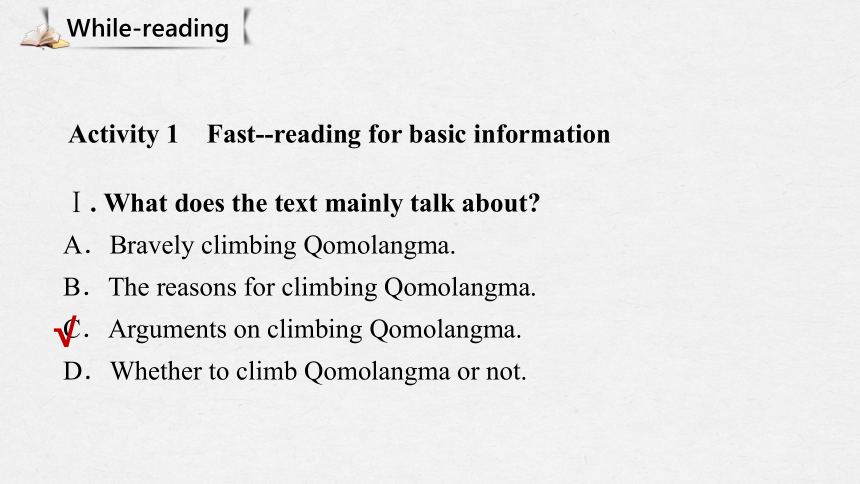
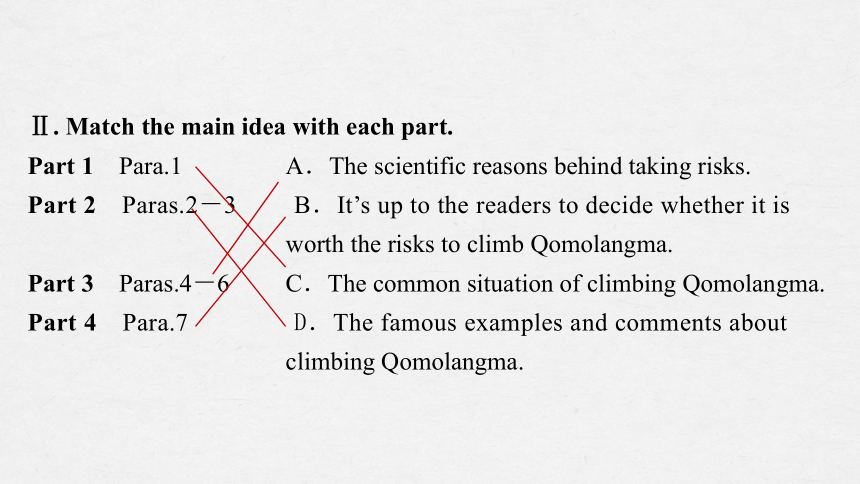

文档简介
(共33张PPT)
Unit 5
What an adventure!
Understanding ideas
By the end of this period, you will be able to:
read for the main idea of the passage;
learn some explorers and their adventures;
work out the structure of the text and the author’s purpose;
learn to express your opinions on taking risks to climbing high mountains.
CONTENTS
Pre-reading
I
While-reading
II
Post-reading
III
Sentences analysis
IV
What do you know about exploration
Mountain
climbing
Navigation
Camping
Rock-climbing
Pre-reading
Have you ever climbed any mountain
Each year, many mountaineers / climbers come to Qomolangma to challenge themselves, among whom there are Chinese climbers.
Do you know some facts about Qomolangma
Look at the map and answer the questions.
1. Who were the first people confirmed to have reached the top of the mountain When did this happen
2. Why do you think the climbers need so many camps along the route
3. What else do you know about Qomolangma
Edmund Hillary and Tenzing Norgay.
In 1953.
It is such a long way that it cannot be done within one day. The climbers need these camps for a rest and adapt themselves to the environment.
1. Who were the first people confirmed to have reached the top of the mountain When did this happen
2. Why do you think the climbers need so many camps along the route
3. What else do you know about Qomolangma
Qomolangma is the world’s highest mountain, located at the border between China and Nepal. In 2005, China remeasured the rock height of the mountain, with a result of 8,844.43m. Qomolangma attracts many climbers, and some of them are highly experienced mountaineers. There are two main climbing routes, one approaching the summit from the south east in Nepal (known as the “standard route”) and the other from the north in China’s Tibet.
Read the passage and find more details!
Ⅰ. What does the text mainly talk about
A.Bravely climbing Qomolangma.
B.The reasons for climbing Qomolangma.
C.Arguments on climbing Qomolangma.
D.Whether to climb Qomolangma or not.
While-reading
Activity 1 Fast- reading for basic information
√
Ⅱ. Match the main idea with each part.
Part 1 Para.1 A.The scientific reasons behind taking risks.
Part 2 Paras.2-3 B.It’s up to the readers to decide whether it is worth the risks to climb Qomolangma.
Part 3 Paras.4-6 C.The common situation of climbing Qomolangma.
Part 4 Para.7 D.The famous examples and comments about climbing Qomolangma.
Ⅰ.Read Para.1 and do the following exercises.
1.What does the author try to tell us in paragraph 1
A.The great benefit of climbing Qomolangma.
B.Two different kinds of Qomolangma climbers.
C.People’s strong desire to climb Qomolangma.
D.The great risks of climbing Qomolangma.
2. What challenges do the climbers face
Crowds, discomfort, danger; extreme cold, low air pressure; becoming sick and losing their lives.
Activity 2 Careful- reading for details
√
3.Why did many Qomolangma climbers decide to try again
A.They didn’t make it in early attempts.
B.They hoped to stay away from crowds.
C.They wanted to take unique adventures.
D.They couldn’t live a life without climbing.
√
For these people,climbing Qomolangma is an experience like no other, making some feel weak and others,powerful.
Why do people climb Qomolangma
George Mallory What people get from this adventure is just __________. People eat and make money to be able to __________, not the other way round.
Alan Arnette Each person has a(n) ___________________ reason for climbing a mountain. It forces people to______________ themselves. To succeed, people must have the physical as well as _______________.
sheer joy
enjoy life
important and unique
look deep inside
mental toughness
Ⅱ.Read Paras. 2-3 and do the following exercises.
1.Complete the table.
√
Do you agree with their opinions Why
2.What do George Mallory and Alan Arnette have in common
A.They both succeeded in climbing Qomolangma.
B.They both climbed many other high mountains afterwards.
C.They both found the risks of climbing worth taking.
D.They both found the real meaning of life and enjoyed it.
√
“What we get from this adventure is just sheer joy ... We do not live to eat and make money.We eat and make money to be able to enjoy life.That iswhat life means and what life is for.”
3.What can be inferred from George Mallory’s words in paragraph 2
A.People care much about eating and making money.
B.It’s hard to find a reason for climbing Qomolangma.
C.Nothing but joy can be felt in climbing Qomolangma.
D.Climbing Qomolangma is a journey of gaining the pleasure of life.
√
“There are a thousand reasons to turn around and only one to keep going. You really have to focus on the one reason that's most important and unique to you. It forces you to look deep inside yourself and figure out if you really have the physical, as well as mental,toughness to push when you want to stop.”
4.What is the most important and unique for us when we want to give up
A.The reasons to turn around.
B.Looking inside ourselves.
C.The physical and mental toughness.
D.Keeping focus on the climbing.
√
George Mallory
Alan Arnette
die on the mountain in 1924
The result
climbed Qomolangma in that year and was going to climb other high mountains around the world
5.Once you have the physical as well as mental toughness,what will you do according to the text
A.Stop going ahead. B.Keep remaining still.
C.Move on. D.Set about exercising.
Ⅲ.Read Paras.4-6 and do the following exercises.
“Type T” personalities,with the “T” standing for “______”,are personality traits that make people more likely to _________ than others.
thrill
take risks
1.What are the “Type T” personalities
√
√
2.Which of the following statements is TRUE
A.Some people like taking risks according to human nature.
B.Climbing Qomolangma costs less money.
C.The passage tells us that it is not worth climbing Qomolangma.
D.George Mallory thought that people should live to make money.
3.What is a person of “Type T” probably like
A.He is interested in making money.
B.He will not go for the mountain climbing.
C.He enjoys the excitement of mountain climbing.
D.He will be a success in his life journey.
√
Research also suggests that our desire to seek risks can be connected to how much we expect to benefit from the result.
4.How can we measure the action of climbing Qomolangma
A.By taking more risks and climbing more.
B.By balancing the benefits and the result.
C.By being an expert and expecting not to die.
D.By equipping ourselves with “Type T” personalities.
√
With this in mind, are the benefits of climbing Qomolangma worth the risks It's totally up to you.
What’s your idea
Ⅳ.Read Para.7 and do the following exercise.
What can we infer from the last paragraph
A.The author likes to climb Qomolangma.
B.It’s worth climbing Qomolangma.
C.It depends on us whether to climb or not.
D.Climbing Qomolangma is dangerous.
Ⅴ.Read the whole passage again and do the following exercise.
1. What is the author’s purpose in writing the passage
A.To encourage people to climb Qomolangma if fully prepared,as risks bring many benefits.
B.To remind people to balance the benefits and risks before deciding to climb Qomolangma.
C.To suggest that people stop taking risks and climbing Qomolangma,as the risks outweigh the benefits.
D.To tell people that there are many stories about the people climbing Qomolangma.
√
Paras. 4–5: Perhaps part of human nature:__________
____________
Climbing Qomolangma: worth the risks
Introducing the topic
Para.1:______________________________________.
Climbing Qomolangma is a special experience
Reasons for the climbers’ risk-taking
Subjective reasons
Scientific reasons
Para. 2 : George Mallory:_____________________
Para. 6:______________________________________.
just pure joy; enjoy life
“Type T”
man’s desire to expect to benefit from the result
Para. 3: Alan Arnette: It forces people to look inside themselves and figure out ______________________
__________________________.
if they really have the
personalities
physical and mental toughness
2. Finish the tasks and retell the passage.
Conclusion
Para 7: It’s up to the readers to decide _______________
_______________________.
whether it is worth
the risks to climb Qomolangma
Post-reading
Activity 1 Discussion
1.Do you agree with Mallory’s and Arnette’s ideas?Why?(Critical thinking)
2.If you were given the chance,would you like to climb Qomolangma Why or why not?(Creative thinking)
Activity 2 Summary
Last year,hundreds of people spent a lot of money on climbing Qomolangma,even though they knew they would be challenged with different risks.For some people,climbing makes them feel 1.________(power).
George Mallory believed that we eat and make money 2.________(enjoy) life.Sadly,he lost his life in 1924 when he 3.____________(climb) Qomolangma.4.__ is still not known if he succeeded in reaching the top before it took his life.Alan Arnette, 5.____ climbed Qomolangma in 2011,held the idea that climbing brought 6.____ focus what was important in our life.He believed that there were a thousand reasons to turn around and only one to keep going.He added,“You have to focus on 7.___ one reason that’s most important and unique to you.It depends on the physical and mental 8._________(tough) to push when you want to give up.”
powerful
to enjoy
was climbing
It
who
into
the
toughness
With the majority of attempts 9._________(result) either in total success or failure,is there a scientific reason?Recent studies indicate that risk-taking may be part of human nature.Besides,people enjoy climbing because they expect to benefit from the result.
Therefore,it’s 10._______(total) up to you whether you will take the risk of climbing Qomolangma.
resulting
totally
1.It is still not known if he succeeded in reaching the top of Qomolangma before it took his life.
[句式分析] 此句为____句。It is still not known...中,It作________,if引导的从句是__________;succeed in doing意为“____________”;before引导________从句。
[自主翻译]
Sentences analysis
复合
形式主语
真正的主语
成功做成……
时间状语
至今人们也不知道他生前是否成功登顶了珠峰。
2.In 2011,words similar to those of Mallory were spoken by American mountain climber Alan Arnette,who climbed Qomolangma in that year and was going to climb other high mountains around the world.
[句式分析] 此句为____句。主句主语和谓语为__________和_______________;similar to...为形容词短语作________;who引导____从句,修饰Alan Arnette。
[自主翻译]
复合
words
were spoken
后置定语
定语
2011年,美国登山家艾伦 阿内特也说过与马洛里类似的话。那一年他登上了珠峰,之后又准备去攀登世界各地其他的高山。
3.It forces you to look deep inside yourself and figure out if you really have the physical,as well as mental,toughness to push when you want to stop.
[句式分析] 此句为____句。force sb to do意为“______________”,figure out意为“____________”,if 引导的从句作figure out的____;when引导____________。
[自主翻译]
复合
迫使某人做……
理解,弄明白
宾语
时间状语从句
它会强迫你去深入地审视自己,去思考自己的身体和心灵是否足够坚强,能在你想放弃的时候推动你继续向前。
4.With the majority of attempts to climb Qomolangma resulting either in total success or failure,is there also a scientific reason behind this risk-taking
[句式分析] 此句为____句。句子主干为___________句型的一般疑问句式;句子开头是With的________,the majority of attempts to climb Qomolangma为____,resulting either in total success or failure为__________。
[自主翻译]
简单
there be
复合结构
宾语
宾语补足语
攀登珠峰的大多数尝试要么大获全胜,要么彻底失败,这一冒险行为的背后是否也有科学解释呢?
5.Research also suggests that our desire to seek risks can be connected to how much we expect to benefit from the result.
[句式分析] 此句为____句。句中suggest意为“__________”,其后由that引导的____从句中使用了____语气;how much引导________,作to的____;benefit from意为“____________”。
[自主翻译]
复合
显示,表明
宾语
陈述
宾语从句
宾语
从……中受益
还有的研究表明,我们对于冒险的渴望与我们期待从中获得多少收益有关。
Write a short passage about your adventure experience or dream.
Homework
Unit 5
What an adventure!
Understanding ideas
By the end of this period, you will be able to:
read for the main idea of the passage;
learn some explorers and their adventures;
work out the structure of the text and the author’s purpose;
learn to express your opinions on taking risks to climbing high mountains.
CONTENTS
Pre-reading
I
While-reading
II
Post-reading
III
Sentences analysis
IV
What do you know about exploration
Mountain
climbing
Navigation
Camping
Rock-climbing
Pre-reading
Have you ever climbed any mountain
Each year, many mountaineers / climbers come to Qomolangma to challenge themselves, among whom there are Chinese climbers.
Do you know some facts about Qomolangma
Look at the map and answer the questions.
1. Who were the first people confirmed to have reached the top of the mountain When did this happen
2. Why do you think the climbers need so many camps along the route
3. What else do you know about Qomolangma
Edmund Hillary and Tenzing Norgay.
In 1953.
It is such a long way that it cannot be done within one day. The climbers need these camps for a rest and adapt themselves to the environment.
1. Who were the first people confirmed to have reached the top of the mountain When did this happen
2. Why do you think the climbers need so many camps along the route
3. What else do you know about Qomolangma
Qomolangma is the world’s highest mountain, located at the border between China and Nepal. In 2005, China remeasured the rock height of the mountain, with a result of 8,844.43m. Qomolangma attracts many climbers, and some of them are highly experienced mountaineers. There are two main climbing routes, one approaching the summit from the south east in Nepal (known as the “standard route”) and the other from the north in China’s Tibet.
Read the passage and find more details!
Ⅰ. What does the text mainly talk about
A.Bravely climbing Qomolangma.
B.The reasons for climbing Qomolangma.
C.Arguments on climbing Qomolangma.
D.Whether to climb Qomolangma or not.
While-reading
Activity 1 Fast- reading for basic information
√
Ⅱ. Match the main idea with each part.
Part 1 Para.1 A.The scientific reasons behind taking risks.
Part 2 Paras.2-3 B.It’s up to the readers to decide whether it is worth the risks to climb Qomolangma.
Part 3 Paras.4-6 C.The common situation of climbing Qomolangma.
Part 4 Para.7 D.The famous examples and comments about climbing Qomolangma.
Ⅰ.Read Para.1 and do the following exercises.
1.What does the author try to tell us in paragraph 1
A.The great benefit of climbing Qomolangma.
B.Two different kinds of Qomolangma climbers.
C.People’s strong desire to climb Qomolangma.
D.The great risks of climbing Qomolangma.
2. What challenges do the climbers face
Crowds, discomfort, danger; extreme cold, low air pressure; becoming sick and losing their lives.
Activity 2 Careful- reading for details
√
3.Why did many Qomolangma climbers decide to try again
A.They didn’t make it in early attempts.
B.They hoped to stay away from crowds.
C.They wanted to take unique adventures.
D.They couldn’t live a life without climbing.
√
For these people,climbing Qomolangma is an experience like no other, making some feel weak and others,powerful.
Why do people climb Qomolangma
George Mallory What people get from this adventure is just __________. People eat and make money to be able to __________, not the other way round.
Alan Arnette Each person has a(n) ___________________ reason for climbing a mountain. It forces people to______________ themselves. To succeed, people must have the physical as well as _______________.
sheer joy
enjoy life
important and unique
look deep inside
mental toughness
Ⅱ.Read Paras. 2-3 and do the following exercises.
1.Complete the table.
√
Do you agree with their opinions Why
2.What do George Mallory and Alan Arnette have in common
A.They both succeeded in climbing Qomolangma.
B.They both climbed many other high mountains afterwards.
C.They both found the risks of climbing worth taking.
D.They both found the real meaning of life and enjoyed it.
√
“What we get from this adventure is just sheer joy ... We do not live to eat and make money.We eat and make money to be able to enjoy life.That iswhat life means and what life is for.”
3.What can be inferred from George Mallory’s words in paragraph 2
A.People care much about eating and making money.
B.It’s hard to find a reason for climbing Qomolangma.
C.Nothing but joy can be felt in climbing Qomolangma.
D.Climbing Qomolangma is a journey of gaining the pleasure of life.
√
“There are a thousand reasons to turn around and only one to keep going. You really have to focus on the one reason that's most important and unique to you. It forces you to look deep inside yourself and figure out if you really have the physical, as well as mental,toughness to push when you want to stop.”
4.What is the most important and unique for us when we want to give up
A.The reasons to turn around.
B.Looking inside ourselves.
C.The physical and mental toughness.
D.Keeping focus on the climbing.
√
George Mallory
Alan Arnette
die on the mountain in 1924
The result
climbed Qomolangma in that year and was going to climb other high mountains around the world
5.Once you have the physical as well as mental toughness,what will you do according to the text
A.Stop going ahead. B.Keep remaining still.
C.Move on. D.Set about exercising.
Ⅲ.Read Paras.4-6 and do the following exercises.
“Type T” personalities,with the “T” standing for “______”,are personality traits that make people more likely to _________ than others.
thrill
take risks
1.What are the “Type T” personalities
√
√
2.Which of the following statements is TRUE
A.Some people like taking risks according to human nature.
B.Climbing Qomolangma costs less money.
C.The passage tells us that it is not worth climbing Qomolangma.
D.George Mallory thought that people should live to make money.
3.What is a person of “Type T” probably like
A.He is interested in making money.
B.He will not go for the mountain climbing.
C.He enjoys the excitement of mountain climbing.
D.He will be a success in his life journey.
√
Research also suggests that our desire to seek risks can be connected to how much we expect to benefit from the result.
4.How can we measure the action of climbing Qomolangma
A.By taking more risks and climbing more.
B.By balancing the benefits and the result.
C.By being an expert and expecting not to die.
D.By equipping ourselves with “Type T” personalities.
√
With this in mind, are the benefits of climbing Qomolangma worth the risks It's totally up to you.
What’s your idea
Ⅳ.Read Para.7 and do the following exercise.
What can we infer from the last paragraph
A.The author likes to climb Qomolangma.
B.It’s worth climbing Qomolangma.
C.It depends on us whether to climb or not.
D.Climbing Qomolangma is dangerous.
Ⅴ.Read the whole passage again and do the following exercise.
1. What is the author’s purpose in writing the passage
A.To encourage people to climb Qomolangma if fully prepared,as risks bring many benefits.
B.To remind people to balance the benefits and risks before deciding to climb Qomolangma.
C.To suggest that people stop taking risks and climbing Qomolangma,as the risks outweigh the benefits.
D.To tell people that there are many stories about the people climbing Qomolangma.
√
Paras. 4–5: Perhaps part of human nature:__________
____________
Climbing Qomolangma: worth the risks
Introducing the topic
Para.1:______________________________________.
Climbing Qomolangma is a special experience
Reasons for the climbers’ risk-taking
Subjective reasons
Scientific reasons
Para. 2 : George Mallory:_____________________
Para. 6:______________________________________.
just pure joy; enjoy life
“Type T”
man’s desire to expect to benefit from the result
Para. 3: Alan Arnette: It forces people to look inside themselves and figure out ______________________
__________________________.
if they really have the
personalities
physical and mental toughness
2. Finish the tasks and retell the passage.
Conclusion
Para 7: It’s up to the readers to decide _______________
_______________________.
whether it is worth
the risks to climb Qomolangma
Post-reading
Activity 1 Discussion
1.Do you agree with Mallory’s and Arnette’s ideas?Why?(Critical thinking)
2.If you were given the chance,would you like to climb Qomolangma Why or why not?(Creative thinking)
Activity 2 Summary
Last year,hundreds of people spent a lot of money on climbing Qomolangma,even though they knew they would be challenged with different risks.For some people,climbing makes them feel 1.________(power).
George Mallory believed that we eat and make money 2.________(enjoy) life.Sadly,he lost his life in 1924 when he 3.____________(climb) Qomolangma.4.__ is still not known if he succeeded in reaching the top before it took his life.Alan Arnette, 5.____ climbed Qomolangma in 2011,held the idea that climbing brought 6.____ focus what was important in our life.He believed that there were a thousand reasons to turn around and only one to keep going.He added,“You have to focus on 7.___ one reason that’s most important and unique to you.It depends on the physical and mental 8._________(tough) to push when you want to give up.”
powerful
to enjoy
was climbing
It
who
into
the
toughness
With the majority of attempts 9._________(result) either in total success or failure,is there a scientific reason?Recent studies indicate that risk-taking may be part of human nature.Besides,people enjoy climbing because they expect to benefit from the result.
Therefore,it’s 10._______(total) up to you whether you will take the risk of climbing Qomolangma.
resulting
totally
1.It is still not known if he succeeded in reaching the top of Qomolangma before it took his life.
[句式分析] 此句为____句。It is still not known...中,It作________,if引导的从句是__________;succeed in doing意为“____________”;before引导________从句。
[自主翻译]
Sentences analysis
复合
形式主语
真正的主语
成功做成……
时间状语
至今人们也不知道他生前是否成功登顶了珠峰。
2.In 2011,words similar to those of Mallory were spoken by American mountain climber Alan Arnette,who climbed Qomolangma in that year and was going to climb other high mountains around the world.
[句式分析] 此句为____句。主句主语和谓语为__________和_______________;similar to...为形容词短语作________;who引导____从句,修饰Alan Arnette。
[自主翻译]
复合
words
were spoken
后置定语
定语
2011年,美国登山家艾伦 阿内特也说过与马洛里类似的话。那一年他登上了珠峰,之后又准备去攀登世界各地其他的高山。
3.It forces you to look deep inside yourself and figure out if you really have the physical,as well as mental,toughness to push when you want to stop.
[句式分析] 此句为____句。force sb to do意为“______________”,figure out意为“____________”,if 引导的从句作figure out的____;when引导____________。
[自主翻译]
复合
迫使某人做……
理解,弄明白
宾语
时间状语从句
它会强迫你去深入地审视自己,去思考自己的身体和心灵是否足够坚强,能在你想放弃的时候推动你继续向前。
4.With the majority of attempts to climb Qomolangma resulting either in total success or failure,is there also a scientific reason behind this risk-taking
[句式分析] 此句为____句。句子主干为___________句型的一般疑问句式;句子开头是With的________,the majority of attempts to climb Qomolangma为____,resulting either in total success or failure为__________。
[自主翻译]
简单
there be
复合结构
宾语
宾语补足语
攀登珠峰的大多数尝试要么大获全胜,要么彻底失败,这一冒险行为的背后是否也有科学解释呢?
5.Research also suggests that our desire to seek risks can be connected to how much we expect to benefit from the result.
[句式分析] 此句为____句。句中suggest意为“__________”,其后由that引导的____从句中使用了____语气;how much引导________,作to的____;benefit from意为“____________”。
[自主翻译]
复合
显示,表明
宾语
陈述
宾语从句
宾语
从……中受益
还有的研究表明,我们对于冒险的渴望与我们期待从中获得多少收益有关。
Write a short passage about your adventure experience or dream.
Homework
